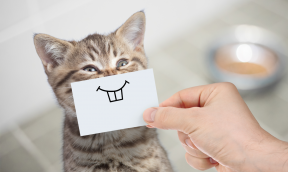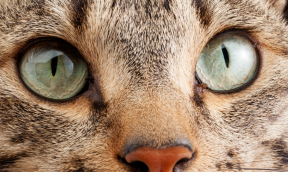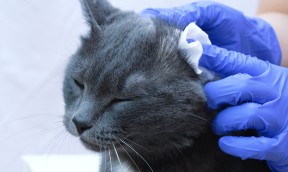
Cleaning a cat’s ears: importance, frequency and technique
Contents: What is special about a cat’s ears? Why is it important to check your cat’s ears? How often should you check and clean your cat’s ears? How do you clean your cat’s ears?

While a cat can practically groom its entire body on its own, it’s difficult for it to reach the inside of its ears. So it needs your help, just like it does to clean its teeth. Cats and kittens may need their ears cleaned because of the particular structure of their ears. An accumulation of earwax can contribute to the development of disease and the proliferation of bacteria. Here Francodex tells you how to take care of your cat and ensure it enjoys its grooming session - something all the more vital in the event of an ear infection.
What is special about a cat’s ears?

Cats’ ears are different from those of a human. This is because the external auditory canal is L-shaped, descending first vertically and then at right angles to the skull, and ending in the eardrum.
Most of the time, earwax is evacuated naturally thanks to the hairs present in the canal.
But in rare cases the particular shape of the canal can lead to an accumulation of earwax at the bottom of it. An accumulation of this waxy, yellowish substance can occur in cats with floppy or folded ears.
Cleaning your cat’s ears is also vital if it has an ear infection.
🐶😺 Are cats and dogs equally likely to get an ear infection? Unlike dogs, which may have floppy ears and be predisposed to having a narrower external auditory canal (depending on the breed), cats are generally less susceptible to bacterial and yeast ear infections. Cats, on the other hand, are more prone to parasitic ear infections. Either way, if your pet seems bothered and is shaking its head and scratching its ears, or if its ears are red, ask your vet.
Why is it important to examine your cat's ears?
Examining your cat’s ears, with or without cleaning them, is an integral part of good hygiene for good health.
Infection prevention
Earwax can accumulate in a cat’s ears, as can debris and dirt. What’s more, the environment of a cat’s ear canal is conducive to parasitic infestations, such as ear scabies.
That’s because a build-up of earwax combined with the heat and humidity present in the auditory canal fosters maceration of the lining and can be the cause of an infection.
Be careful, cleaning your cat’s or kitten’s ears in the absence of an identified health problem can increase the risk of ear infections! On the other hand, cleaning is essential if your pet has otitis, as this can damage a cat’s hearing if left untreated.
When it comes to a kitten’s ears, be sure to use a lotion designed for their sensitive ears, such as Francodex cleansing lotion for kittens and puppies.
Early detection of health problems
Regularly examining your cat’s ears will help you detect any problems, such as:
- rashes,
- scabs,
- ear mites (the parasite that causes ear scabies),
- an unusual smell,
- or an excessive amount of wax.
If your feline regularly goes outside, it will be all the more exposed to possible disorders. It could even injure its ear by going under a wire fence.
🙀 Cat scabies: be aware that if the earwax in your cat’s ear turns black and gives off a strong smell then it is likely that it has been infested by Otodectes cynotis (ear mites). The scabies parasite can colonise the whole ear. Your cat may also seem bothered and scratch its ears. An appointment with your vet is essential for an accurate diagnosis and appropriate treatment.
Comfort and well-being
Examining a cat’s ears also simply makes it feel more comfortable.
Itching and ear pain can make animals irritable. Good ear care can prevents such symptoms, and can also help relieve them if they occur.
Moreover, caring for your pet helps to strengthen the bonds between you, bringing you closer in your day to day lives.
A cat that’s used to being handled when you check its ears will be more inclined to let you treat a potential ear infection.
For gentle cleaning, Francodex has developed a range of organic products for cats and kittens, all made in France: Biodene. Discover our ear cleanser for cats and dogs.
Protecting hearing
Cats have extremely good hearing, which helps them hunt.
An accumulation of wax or an untreated ear infection affects a cat’s hearing.
Wax can block the ear canal. Sounds have more difficulty reaching the eardrum and the internal parts of the ear. The cat’s ability to hear is diminished and this can cause them to lose their bearings.
By keeping its ears clean, you are helping to preserve your pet’s hearing function.
How often should you check and clean your cat’s ears?
Depending on the individual and the breed, the amount of earwax produced can vary greatly.
If your pet rarely has dirty ears, cleaning the ear flap, or pinna, once or twice a month is sufficient to get it used to being handled. Don’t touch the ear canal, as you could weaken it and increase the risk of infection.
We recommend you always have Francodex multi-purpose wipes to hand, so you can clean your pet’s ears, eyelids and paws in a matter of seconds. They arethe ideal complement to a complete ear check every month. You should only clean the ear flap if there has been a build-up of earwax.
🐈 When should you never clean your cat’s ears? Foreign bodies in the ear - particularly grass spikelets in summer - can also be the cause of otitis, excessive earwax secretion and ear-scratching. In such cases, it’s vital you don’t clean the ear, as this could lead to perforation of the eardrum. Furthermore, cleaning products should not be used when the eardrum is damaged.
If your pet often has dirty ears, you can clean the ear flap once a week. Similarly, if your pet has a history of ear infections, for example, the ears may need to be washed more frequently, depending on your vet’s advice.
However, don’t clean them too frequently either, or this might harm the flora of the ear!
If you’re not sure how or how often to clean your cat’s ears, or if your cat's ears are very often dirty or smelly or it keeps scratching at them, it’s best to consult a vet.
This animal health professional will show you the correct cleaning technique and recommend a cleaning frequency suited to your cat.
How do you clean your cat’s ears?
Cleaning your cat’s ears may seem like a daunting task, but with patience and the right technique, it can be done safely at home if your moggie is up for it. However, we suggest you get your pet used to having its ears handled from an early age. Here’s what to do.
Preparing to clean your cat’s ears

To ensure that your cat’s ears are cleaned properly in the event of an ear infection, make sure to put the odds in your favour:
- Choose the right time to start cleaning its ears, when your cat is calm and relaxed.
- Get everything ready. You’ll need an ear cleaning solution specially designed for cats, such as Francodex ear cleaning lotion, which respects the skin of the external auditory canal. You can use a compress to wipe off any excess product along with any impurities removed. Don’t forget some treats to reward your cat afterwards!
- Find a quiet, well-lit spot, if possible one that your cat likes to use, to clean its ears.
The process of cleaning a cat’s ears
Make sure you hold your cat firmly but gently to avoid any sudden movements. You may need to enlist the help of another person to hold your pet while you clean its ears if it tends to move around.
Pour a few drops of the cleansing solution into your cat’s ear, following the instructions on the packaging. To avoid bacterial contamination, do not let the tip of the bottle touch the ear.
⚠️ Never insert an object like a cotton bud into the ear canal!

Gently massage the base of the ear to help distribute the cleansing solution and dislodge any wax or debris.
Use a compress to wipe away the excess liquid along with any impurities in the outer ear. Do not push the compress too far into the ear canal!
Give your cat a treat to reward it for staying calm and then let it go! It will certainly need to spend some time grooming itself after this somewhat stressful experience.
Observe your cat after the ear-cleaning sessions for any signs of discomfort or irritation.
Some cats can be stressed, even aggressive, and may not tolerate ear cleaning. If this is the case, we recommend that you seek professional help, but don’t give up on the whole idea!
What’s more, if your cat has particularly dirty ears or seems to have frequent ear problems, consulting an animal health expert can help detect an underlying health problem at an early stage and treat it without delay.
Article written with the assistance of *
Dr Stéphanie Padiolleau, veterinary surgeon




